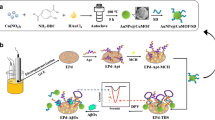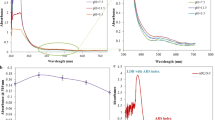Abstract
An electrochemical biosensor is described for highly sensitive determination of tDNA, an Alzheimer’s disease (AD)-related biomarker. Electroactive molybdophosphate anions were precipitated in-situ on a glassy carbon electrode (GCE) via catalytic hydrolysis by alkaline phosphatase (ALP). This is followed by recycling amplification of tDNA. Four DNA strands (referred to as S1, S2, S3 and S4) were designed to assemble X-shape DNA (X-DNA) building blocks. These were further extended into four directions under the action of DNA polymerase. The resultant two X-DNA motifs were polymerize. Simultaneously, ALP is encapsulated into a hydrogels network to obtain a porous material of type ALP@DNAhg. The GCE was modified with reduced graphene oxide functionalized with gold nanoparticles (Au@rGO). If ALP@DNAhg are captured via strand displacement, tDNA recycling assembly for signal amplification is initiated. This results in the immobilization of large amounts of ALP. On introduction of pyrophosphate and molybdate (MoO42−), ALP will catalyze the hydrolysis of pyrophosphate to produce phosphate. It will react with molybdate to form redox active phosphomolybdate anions (PMo12O403−). Its amperometrical signal depends on the concentration of tDNA in the 1.0 × 10−2 to 1.0 × 104 pM concentration range, and the detection limit is 3.4 × 10−3 pM.

Schematic presentation of (a) preparation of alkaline phosphatase-encapsulated DNA hydrogel (ALP@DNAhg). (b) fabrication of the biosensor for target DNA (tDNA) based on ALP@DNAhg to catalyze in situ precipitation of electroactive molybdophosphate anion (PMo12O403−) and tDNA recycling amplification, achieving tDNA-dependent electrochemical signal readout (X-DNA: X-shape DNA building block. TdT: terminal deoxynucleotidyl transferase. dATP: deoxyadenosine triphosphate. dTTP: deoxythymidine triphosphate. X-DNA-pAn and X-DNA-pTn: X-DNA motifs with poly-A and poly-T tails. ALP: alkaline phosphatase. ALP@DNAhg: ALP-encapsulated DNA hydrogels. Au@rGO: gold nanoparticles-functionalized reduced graphene oxide. GCE: glass carbon electrode. HP1, 2: hairpin DNA 1, 2. MCH: 6-mercaptohexanol. tDNA: target DNA. CV: cyclic voltammetry).





Similar content being viewed by others
References
Su S, Sun HF, Cao WF, Chao J, Peng HZ, Zuo XL, Yuwen LH, Fan CH, Wang LH (2016) Dual-target electrochemical biosensing based on DNA structural switching on gold nanoparticle-decorated MoS2 nanosheets. ACS Appl Mater Interfaces 8:6826–6833
Cui L, Lu MF, Li Y, Tang B, Zhang CY (2018) A reusable ratiometric electrochemical biosensor on the basis of the binding of methylene blue to DNA with alternating AT base sequence for sensitive detection of adenosine. Biosens Bioelectron 102:87–93
Zhao J, Gao J, Zheng T, Yang Z, Chai Y, Chen S, Yuan R, Xu W (2018) Highly sensitive electrochemical assay for Nosema bombycis gene DNA PTP1 via conformational switch of DNA nanostructures regulated by H+ from LAMP. Biosens Bioelectron 106:186–192
Zheng TT, Zhang QF, Feng S, Zhu JJ, Wang Q, Wang H (2014) Robust nonenzymatic hybrid nanoelectrocatalysts for signal amplification toward ultrasensitive electrochemical cytosensing. J Am Chem Soc 136:2288–2291
Ngo TA, Nakata E, Saimura M, Morii T (2016) Spatially organized enzymes drive cofactor-coupled cascade reactions. J Am Chem Soc 138:3012–3021
Lv YQ, Chen SY, Shen YF, Ji JJ, Zhou Q, Liu SQ, Zhang YJ (2018) Competitive multiple-mechanism-driven electrochemiluminescent detection of 8-hydroxy-2′-deoxyguanosine. J Am Chem Soc 140:2801–2804
Wu YM, Xu WJ, Bai LJ, Yuan YL, Yi HY, Chai YQ, Yuan R (2013) Ultrasensitive thrombin detection based on direct electrochemistry of highly loaded hemoglobin spheres-encapsulated platinum nanoparticles as labels and electrocatalysts. Biosens Bioelectron 50:50–56
Xu MD, Zhuang JY, Chen X, Chen GN, Tang DP (2013) A difunctional DNA–AuNP dendrimer coupling DNAzyme with intercalators for femtomolar detection of nucleic acids. Chem Commun 49:7304–7306
Liu TZ, Hu R, Zhang X, Zhang KL, Liu Y, Zhang XB, Bai RY, Li DL, Yang YH (2016) Metal–organic framework nanomaterials as novel signal probes for electron transfer mediated ultrasensitive electrochemical immunoassay. Anal Chem 88:12516–12523
Li JY, Si L, Bao JC, Wang ZY, Dai ZH (2017) Fluorescence regulation of poly(thymine)-templated copper nanoparticles via an enzyme-triggered reaction toward sensitive and selective detection of alkaline phosphatase. Anal Chem 89:3681–3686
Si Z, Xie B, Cahen Z, Tang C, Li T, Yang M (2017) Electrochemical aptasensor for the cancer biomarker CEA based on aptamer induced current due to formation of molybdophosphate. Microchim Acta 184:3215–3221
Sadakane M, Steckhan E (1998) Electrochemical properties of polyoxometalates as electrocatalysts. Chem Rev 98:219–237
Huang YX, Tang C, Liu J, Cheng J, Si ZZ, Li T, Yang MH (2017) Signal amplification strategy for electrochemical immunosensing based on a molybdophosphate induced enhanced redox current on the surface of hydroxyapatite nanoparticles. Microchim Acta 184:855–861
Qu FL, Yang MH, Rasooly A (2016) Dual signal amplification electrochemical biosensor for monitoring the activity and inhibition of the Alzheimer’s related protease β-secretase. Anal Chem 88:10559–10565
Hu LS, Hu SQ, Guo LY, Shen CC, Yang MH, Rasooly A (2017) DNA generated electric current biosensor. Anal Chem 89:2547–2552
Feng KJ, Liu J, Deng L, Yu HJ, Yang MH (2018) Amperometric detection of microRNA based on DNA-controlled current of a molybdophosphate redox probe and amplification via hybridization chain reaction. Microchim Acta 185:28
Xie SB, Yuan YL, Chai YQ, Yuan R (2015) Tracing phosphate ions generated during loop-mediated isothermal amplification for electrochemical detection of Nosema bombycis genomic DNA PTP1. Anal Chem 87:10268–10274
Cai W, Xie SB, Tang Y, Chai YQ, Yuan R, Zhang J (2017) A label-free electrochemical biosensor for microRNA detection based on catalytic hairpin assembly and in situ formation of molybdophosphate. Talanta 163:65–71
Shen CC, Li XZ, Rasooly A, Guo LY, Zhang K, Yang MH (2016) A single electrochemical biosensor for detecting the activity and inhibition of both protein kinase and alkaline phosphatase based on phosphate ions induced deposition of redox precipitates. Biosens Bioelectron 85:220–225
He Y, Yang X, Yuan R, Chai YQ (2017) Switchable target-responsive 3D DNA hydrogels as a signal amplification strategy combining with SERS technique for ultrasensitive detection of miRNA 155. Anal Chem 89:8538–8544
Lilienthal SV, Shpilt ZH, Wang F, Orbach R, Willner I (2015) Programmed DNAzyme-triggered dissolution of DNA-based hydrogels: means for controlled release of biocatalysts and for the activation of enzyme cascades. ACS Appl Mater Interfaces 7:8923–8931
Li J, Zheng C, Cansiz S, Wu CC, Xu JH, Cui C, Liu Y, Hou WJ, Wang YY, Zhang LQ, Teng IT, Yang HH, Tan WH (2015) Self-assembly of DNA nanohydrogels with controllable size and stimuli-responsive property for targeted gene regulation therapy. J Am Chem Soc 137:1412–1415
Li J, Mo LT, Lu CH, Fu T, Yang HH, Tan WH (2016) Functional nucleic acid-based hydrogels for bioanalytical and biomedical applications. Chem Soc Rev 45:1410
Zhou L, Sun N, Xu LJ, Chen X, Cheng H, Wang J, Pei RJ (2016) Dual signal amplification by an “on-command” pure DNA hydrogel encapsulating HRP for colorimetric detection of ochratoxin A. RSC Adv 6:114500–114504
Zhu XL, Mao XX, Wang ZH, Feng C, Chen GF, Li GX (2017) Fabrication of nanozyme@ DNA hydrogel and its application in biomedical analysis. Nano Res 10:959–970
Mao XX, Chen GF, Wang ZH, Zhang YG, Zhu XL, Li GX (2018) Surface-immobilized and self-shaped DNA hydrogels and their application in biosensing. Chem Sci 9:811–818
Zhu Z, Guan Z, Jia S, Lei Z, Lin S, Zhang H, Ma Y, Tian ZQ, Yang CJ (2014) Au@ Pt nanoparticle encapsulated target-responsive hydrogel with volumetric bar-chart chip readout for quantitative point-of-care testing. Angew Chem Int Ed 53:12503–12507
Liu SF, Wang CF, Zhang CX, Wang Y, Tang B (2013) Label-free and ultrasensitive electrochemical detection of nucleic acids based on autocatalytic and exonuclease III-assisted target recycling strategy. Anal Chem 85:2282–2288
Wu XY, Chai YQ, Zhang P, Yuan R (2015) An electrochemical biosensor for sensitive detection of microRNA-155: combining target recycling with cascade catalysis for signal amplification. ACS Appl Mater Interfaces 7:713–720
Shen CC, Zeng K, Luo JJ, Li XQ, Yang MH, Rasooly A (2017) Self-assembled DNA generated electric current biosensor for HER2 analysis. Anal Chem 89:10264–10269
Long GL, Winefordner JD (1983) Limit of detection. A closer look at the IUPAC definition. Anal Chem 55:712A–724A
Radi AE, Sanchez GLA, Baldrich E, O’Sullivan CK (2006) Reagentless, reusable, ultrasensitive electrochemical molecular beacon aptasensor. J Am Chem Soc 28:117–124
Zhou ZX, Wei W, Zhang YJ, Liu SQ (2013) DNA-responsive disassembly of AuNP aggregates: influence of nonbase-paired regions and colorimetric DNA detection by exonuclease III aided amplification. J Mater Chem B 1:2851–2858
Gao Y, Li BX (2014) Exonuclease III-assisted cascade signal amplification strategy for label-free and ultrasensitive chemiluminescence detection of DNA. Anal Chem 86:8881–8887
Huang YL, Gao ZF, Luo HQ, Li NB (2017) Sensitive detection of HIV gene by coupling exonuclease III-assisted target recycling and guanine nanowire amplification. Sens Actuators B Chem 238:1017–1023
Liu CC, Kanekiyo T, Xu HX, Bu GJ (2013) Apolipoprotein E and Alzheimer disease: risk, mechanisms and therapy. Nat Rev Neurol 9:106–118
Yang ZH, Zhuo Y, Yuan R, Chai YQ (2015) Amplified thrombin aptasensor based on alkaline phosphatase and hemin/G-quadruplex-catalyzed oxidation of 1-naphthol. ACS Appl Mater Interfaces 7:10308–10315
Acknowledgements
The financial support by the National Natural Science Foundation (NNSF) of China (21775123) and the Natural Science Foundation Project of Chongqing (cstc2018jcyjAX0214) to this work was deeply appreciated.
Author information
Authors and Affiliations
Corresponding author
Ethics declarations
The author(s) declare that they have no competing interests.
Additional information
Publisher’s note
Springer Nature remains neutral with regard to jurisdictional claims in published maps and institutional affiliations.
Electronic supplementary material
ESM 1
(DOC 540 kb)
Rights and permissions
About this article
Cite this article
Hua, X., Zhou, X., Guo, S. et al. Determination of Alzheimer biomarker DNA by using an electrode modified with in-situ precipitated molybdophosphate catalyzed by alkaline phosphatase-encapsulated DNA hydrogel and target recycling amplification. Microchim Acta 186, 158 (2019). https://doi.org/10.1007/s00604-019-3283-2
Received:
Accepted:
Published:
DOI: https://doi.org/10.1007/s00604-019-3283-2




